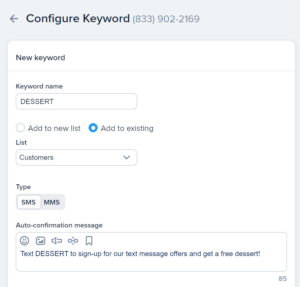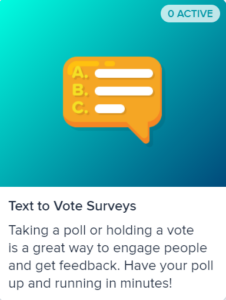SMS Marketing Metrics: How to Measure Your Success With Text Marketing
With so much you could measure, where should you focus? Here are my recommendations for SMS marketing metrics and KPIs.
The three most important letters to any marketer are K-P-I (in that order 😉). KPIs, or key performance indicators, are the numerical measures that determine the success of your marketing efforts.
Sometimes referred to as metrics or deliverables, these benchmarks are something that should be established before you begin any kind of SMS marketing campaign.
The temptation to begin a new marketing effort without much of a plan is very prevalent. A lot of the time we hear people say, “We’ll just figure it out along the way.”
While we commend your confidence, we suggest you take up a new motto: PPPPPP—prior proper planning prevents poor performance.
Starting every campaign with metrics that help you determine what’s working (and what isn’t) will ensure you stay focused and successful.
Not to mention, when your team or supervisor asks you to justify the investment you’re making in an SMS marketing campaign, solid benchmarks will help demonstrate what a knockout job you’ve been doing.
Benchmarks can always be adjusted to fit the needs of your business. However, to help you establish a framework, we’ll get you started with the top six metrics to look out for in your SMS marketing campaigns.
SMS marketing metrics:
- Subscriber growth rates
- Unsubscribe rates
- Clickthrough rates
- Conversion rates
- Keyword engagement metrics
- Average response time
SMS marketing benchmarks:
- Unsubscribe rates: 3% or less
- Clickthrough rates: 20% or greater
- Conversion rates: 29% or greater
- Average response times: 1 hour or less
SimpleTexting is SMS marketing software
1. Contact growth rates
Contacts are the people who make up your SMS subscriber list(s) and receive your marketing messages.
While your texts could be the best in the business, if nobody is reading them, they won’t be worth a hill of beans. Contacts are the bedrock to reaching your SMS marketing campaign goals.
You want to ensure that you are constantly growing your list and reaching more people with your campaigns. Tracking monthly contact growth (or loss) will help you determine if you have a healthy text marketing strategy and if you’re advertising in the right places.
Subscriber growth rate calculation:
Subscriber growth rate = (latest number of subscribers / baseline number of subscribers) – 1
SMS subscriber growth rate calculation example:
20% subscriber growth rate = (120 subscribers in February / 100 subscribers in January) – 1
SMS subscriber list metrics that are good to measure:
- Total number of subscribers in your list
- The number of additional subscribers month over month
- Subscriber growth rate month over month
There is no benchmark on list size or growth rate because it depends on your target audience size. The following metrics will help you understand if your SMS marketing strategy is healthy.
2. Contact unsubscribe rates
With quantity comes quality. As much as you want to continue to grow your contacts, you also want to ensure you keep those contacts.
A quick note on SMS marketing campaigns. Every one of your contacts must provide you with express written consent for you to send them messages.
This also means they can choose to opt out, or no longer receive your texts, at any time. If you have large numbers of people opting out of your campaigns, that’s generally an indication that you’re not sending out the right kind of content.
So, just as you track your monthly contact count, you should also monitor opt-outs for any unusually high spikes.
SMS unsubscribe rate calculation:
SMS unsubscribe rate = (contacts who unsubscribed / total number of contacts)
SMS unsubscribe rate calculation example:
2% SMS unsubscribe rate = (2 contacts who unsubscribed / 100 total number of contacts)
We recommend setting a benchmark of less than 3% SMS unsubscribe rate.
3. Clickthrough rates
While valuable, this metric is only relevant if you’re sending out messages with links to a webpage. When you send a message including a link, that should never be the end of the road.
You should always track how many clicks your links are getting because it’s an indication of how engaging your content is.
If the links you’re sending out are going unopened, that’s generally a sign that you’re not sending the most relevant material for your contacts.
SMS clickthrough rate calculation:
SMS clickthrough rate = (subscribers who clicked the text message / total number of subscribers who received the text message)
SMS clickthrough rate calculation example:
45 SMS clickthrough rate = (45 subscribers who clicked the text message / 100 subscribers who received the text)
A recent original dataset we published at SimpleTexting suggests you can set an SMS clickthrough rate benchmark of 20% or greater.
4. Conversion rates
SMS campaigns have lots of goals. Maybe you’re using it to grow your email list, drive purchases, or encourage replies.
You’ll need to determine your conversion rates to make sure your text messages are helping you reach those goals.
To calculate a conversion rate, divide the number of contacts that took an action by the total number of contacts your campaign was sent to.
SMS conversion rate calculation:
SMS conversion rate = (subscribers who completed desired action / total number of subscribers who received the text message)
SMS conversion rate calculation example:
30% SMS conversion rate = (30 subscriber conversions / 100 subscribers who received the text message)
If you’re driving people to make a purchase or take action on your website, you can use a special piece of code called a UTM, or tracking code, to determine your conversion rate.
Use a tool such as Google UTM Builder and their extensions to help you add the custom UTM for your campaign, then add it to the link in your SMS campaign.
With this code in place, each time someone makes a purchase on your site, you’ll know whether or not they came from the link in your campaign. Simple as that.
In a curated study we conducted at SimpleTexting, we recommend you set an SMS conversion rate benchmark of 29%.
5. Keyword engagement metrics
How are keywords helping you grow and engage your SMS subscriber list? You can measure the number of subscribers who use your keywords to know how effective they are at influencing the desired behaviors.
Should the call to action (CTA) asking people to join your contact list have a sense of urgency? Maybe it should feel more exclusive?
Or what about if you offer a discount for joining? Hone in on exactly what convinces people to join your list by using keywords to test your CTAs.
For example, a restaurant could create a series of two table tents asking people to sign up. One could say, “Text DESSERT to sign-up for our text message offers and get a free dessert!”

Another could say, “Text VIP to sign-up for exclusive offers sent to your phone directly via text. You won’t find these deals anywhere else!”
Both of these keywords can route to the same list, but by using separate keywords the restaurant will know what motivates their customers to sign up.
6. Average response times
Lastly, we have an internal SMS marketing campaign metric that can be used to audit your team’s efficiency.
Because a large majority of texts are read so quickly, your customers tend to expect their messages to receive a response just as quickly. In order to achieve peak performance, you should strive to answer customer messages as quickly as they arrive.
Aim to respond to text messages within the hour, and do your very best to never leave a text unread for more than 24 hours. Calculating your average monthly response time is important to keep yourself honest and ensure your providing the best customer service experience possible.
In addition, measuring response time is a great way to check in and determine if you’re sending texts at the most convenient time for your users. With a little trial and error, you’ll collect enough data to determine the optimum time to send your messages!
Use these SMS metrics to make data-driven decisions
Measuring your SMS marketing KPIs constantly will help you stay ahead of any issues with your SMS campaigns. But at the end of the day, you should never be afraid to go right to the source for feedback.
Sending Text to Vote Polls to your contacts asking them if there’s anything you can do better will achieve two things.

First, it will let your customers know you care about them and their opinions. Second, it’ll give you candid, concrete feedback that can go on to give you even more targeted benchmarks and measures.
Data is the name of the game, and nobody knows that better than our team here at SimpleTexting.
The important thing to remember is that every industry and business is so different. It’s impossible to provide a magic number that serves as the gold standard for engagement.
Our best tip is to consider your first couple messages your benchmark and aim to improve from there. That’s why we’ve designed the SimpleTexting measurement dashboards to make it easy and intuitive to track all of these KPIs and more.
Continually monitor your campaign performance with our tools and you’ll become a figures guru faster than you can say “PPPPPP” ten times fast!
This piece was originally published as a blog post April 3, 2019. It was refreshed and repurposed May 16, 2023. Meghan Tocci and Nathan Ellering contributed to this piece.